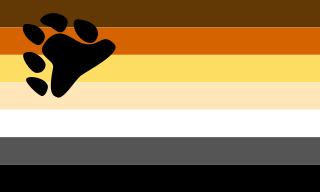
In gay culture, a bear is a man who is fat, hairy, or both.

Leather subculture denotes practices and styles of dress organized around sexual activities that involve leather garments, such as leather jackets, vests, boots, chaps, harnesses, or other items. Wearing leather garments is one way that participants in this culture self-consciously distinguish themselves from mainstream sexual cultures. Many participants associate leather culture with BDSM practices and its many subcultures. For some, black leather clothing is an erotic fashion that expresses heightened masculinity or the appropriation of sexual power; love of motorcycles, motorcycle clubs and independence; and/or engagement in sexual kink or leather fetishism.

The leather pride flag is a symbol of leather subculture as well as kink and fetish subcultures more broadly, including BDSM. The flag was designed by Tony DeBlase in 1989.

Folsom Street Fair (FSF) is an annual BDSM and leather subculture street fair, held in September that concludes San Francisco's "Leather Pride Week". The Folsom Street Fair, sometimes referred to simply as "Folsom", takes place on the last Sunday in September, on Folsom Street between 8th and 13th Streets, in San Francisco's South of Market district.

Gayle S. Rubin is an American cultural anthropologist, theorist and activist, best known for her pioneering work in feminist theory and queer studies.

The Leather Archives & Museum (LA&M) is a community archives, library, and museum located in the Rogers Park neighborhood of Chicago, Illinois. Founded by Chuck Renslow and Tony DeBlase in 1991, its mission is "making leather, kink, BDSM, and fetish accessible through research, preservation, education and community engagement." Renslow and DeBlase founded the museum in response to the AIDS crisis, during which the leather and fetish communities' history and belongings were frequently lost or intentionally suppressed and discarded.
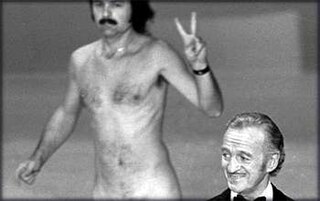
Robert Opel was an American photographer and art gallery owner most famous for streaking during the 46th Academy Awards in 1974.
The Bay Area Reporter is a free weekly LGBT newspaper serving the LGBT communities in the San Francisco Bay Area. It is one of the largest-circulation LGBT newspapers in the United States, and the country's oldest continuously published newspaper of its kind.

Charles "Chuck" Arnett was an American artist and dancer. His best-known work is the Tool Box mural (1962).

John Joseph "Jack" Fritscher is an American author, university professor, historian, and social activist known internationally for his fiction, erotica, and nonfiction analyses of pop culture and gay male culture. An activist prior to the Stonewall riots, he was an out and founding member of the Journal of Popular Culture. Fritscher became highly influential as editor of Drummer magazine.
Drummer is an American magazine which focuses on "leathersex, leatherwear, leather and rubber gear, S&M, bondage and discipline, erotic styles and techniques." The magazine was launched in 1975 and ceased publication in April 1999 with issue 214, but was relaunched 20 years later by new publisher Jack MacCullum with editor Mike Miksche.

The Caldron was a sex club for gay men located at 953 Natoma Street in San Francisco's South of Market neighborhood. It opened in 1980 and closed in 1984. It was called "the epitome of the uninhibited, abandoned, 'sleazy' sex club."

REX was an American visual artist and illustrator closely associated with gay fetish art of 1970s and 1980s New York and San Francisco. He avoided photographs and did not discuss his personal life. His drawings influenced gay culture through graphics made for nightclubs including the Mineshaft and his influence on artists such as Robert Mapplethorpe. Much censored, he remained a shadowy figure, saying that his drawings "defined who I became" and that there are "no other 'truths' out there". REX died in Amsterdam in late March 2024.

Sean and Shawn were the pen-names of John Klamik, was an American artist specializing in gay male erotica and comics. His homosexual-themed cartoons were among the first to appear in US publications, including a regular feature in the early years of The Advocate. He worked under two pen names: Shawn for more mainstream gay publications such as In Touch, and Sean for fetish publications such as Drummer and Bound & Gagged.
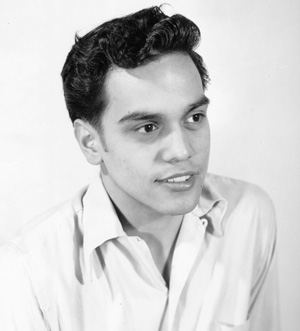
Domingo Francisco Juan Esteban "Dom" Orejudos, Secundo, also widely known by the pen names Etienne and Stephen, was an openly gay artist, ballet dancer, and choreographer, best known for his ground-breaking gay male erotica beginning in the 1950s. Along with artists George Quaintance and Touko Laaksonen —with whom he became friends—Orejudos' leather-themed art promoted an image of gay men as strong and masculine, as an alternative to the then-dominant stereotype as weak and effeminate. With his first lover and business partner Chuck Renslow, Orejudos established many landmarks of late-20th-century gay male culture, including the Gold Coast bar, Man's Country bathhouse, the International Mr. Leather competition, Chicago's August White Party, and the magazines Triumph, Rawhide, and Mars. He was also active and influential in the Chicago ballet community.
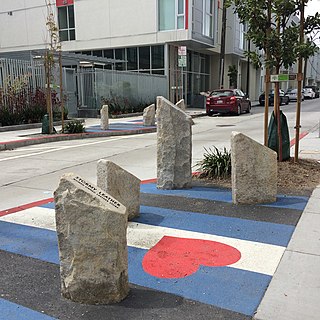
The San Francisco South of Market Leather History Alley consists of four works of art that honor the history of gay and lesbian leather culture in South of Market, San Francisco. The art is embedded in Ringold Street, an alley between 8th and 9th Street. The installation opened in 2017. The alley is part of the Leather and LGBTQ Cultural District.

The Leather and LGBTQ Cultural District is a cultural district in San Francisco's South of Market (SOMA) neighborhood commemorating the history and culture of the leather subculture active in the area for approximately half a century. The San Francisco Board of Supervisors established the district with legislation signed into law by the mayor on May 9, 2018. A ribbon cutting was held on June 12 that year outside the Stud on 9th St.
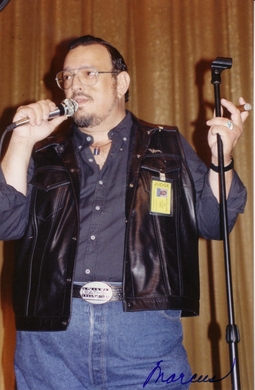
Tony DeBlase (1942–2000), also known as Anthony DeBlase, was part of the BDSM and leather subcultures. He was the designer of the leather pride flag.

Charles Edward Kerbs, better known by his pen name MATT, was an American artist, actor, and playwright active in the late twentieth century, known for his erotic illustrations.
The Tool Box was a leather bar for gay men in San Francisco that operated from 1962 to 1971 on the east corner of 4th Street and Harrison Street. It was the first leather bar in the South of Market, and a meeting spot where influential personalities of the early San Francisco leather scene gathered. After a prominent feature in Life magazine in 1964, it was considered the archetypal leather bar, helping to cement San Francisco's reputation as the “gay capital” of the US. The bar's history was short-lived: from 1965 onwards, the epicenter of the leather scene shifted towards Folsom Street, which ultimately led to its closing in 1971. The Tool Box is commemorated at the San Francisco South of Market Leather History Alley.















